“One major misconception about abstract art is that it is simply the random, haphazard application of paint without direction or reference, and some might even say, artistic skills,” says Elaine Daily-Birnbaum. “This view is most generally held by one not educated in art.

“However, the principles of composition and design elements are even more crucial to a successful abstract painting than to a representational or realistic painting. Without a distinct subject, an abstract painting must depend solely on the successful application of these principles and elements to create an image of visual interest and intrigue. An abstract painting must overcome the brain’s natural desire to identify an object.
“Even before I ever painted abstractly, I was drawn to abstract paintings — paintings that provided me with a unique, subjective experience, paintings that provoked an emotional or psychological response, paintings that flirted with my mind. I prefer not to be told everything, but rather be allowed to experience the qualia of a painting.
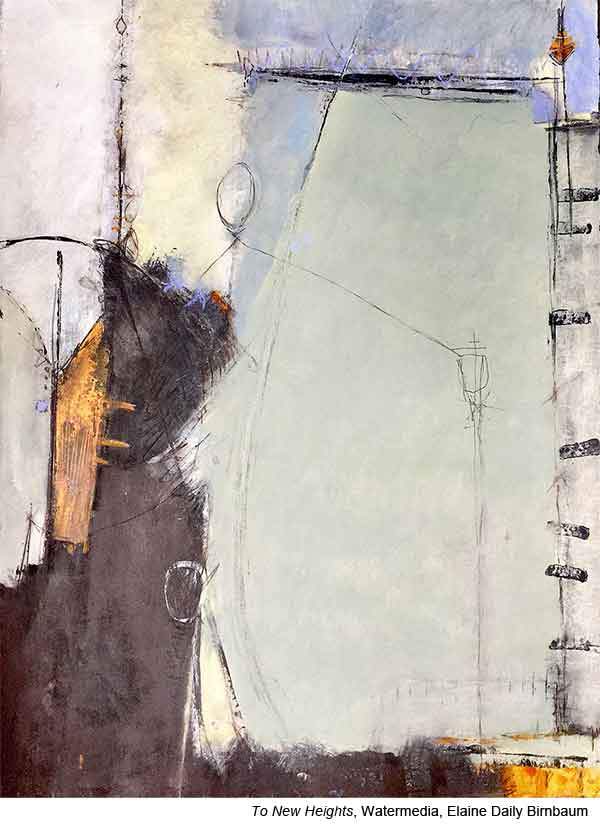
“To me, suggestion can be more powerful than reality. I agree with Albert Einstein that “The most beautiful thing we can experience is the mysterious. It is the source of all true art and all science.”
“In addition, I love the freedom of expression that abstract painting affords me. That process of exploration and discovery with paint is what I find so exciting. The outcome may or may not be satisfying, but, oh, the ride getting there.”

WATERMEDIA PAINTING PROCESS
“I begin each painting by applying a warm or cool color to the entire paper. The specific color often depends on what’s remaining on my palette, although there are times I purposefully choose a particular color for this initial coat.
“Next, I may draw on the paper with Caran d’Ache crayons or inks in a somewhat exploratory manner. These marks become part of the background, some “history,” that may or may not be revealed in the final piece.
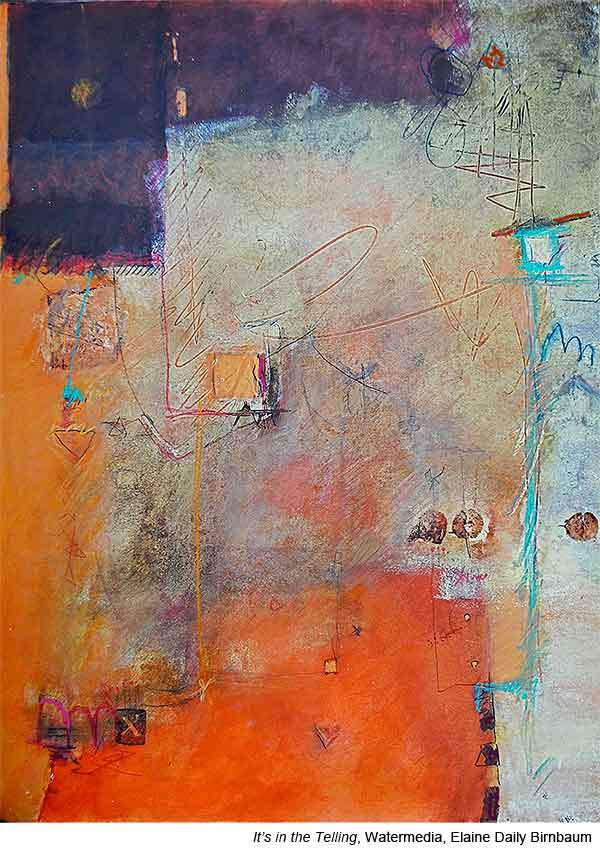
“From there, I continue to apply many thin layers of watermedia (watercolor, acrylic, gouache, inks, etc.) wiping after each layer to remove some and leave some, thus furthering the “history” and depth of the painting. (At times, I think I take off more paint than I put on!) During this process, I am totally immersed and almost hyperacutely aware of what’s transpiring visually and begin to find my anchor and get a sense of the direction I wish to pursue. This becomes more firmly established with each additional brush stroke or mark as I inwardly explore a concept or idea in paint.
“I continue working and re-working the painting until it begins to speak to my soul. Many times artists I paint with have suggested I stop. that the piece I am working on is finished. They are dismayed that when they next see it that I have painted over it or changed it in some major way.
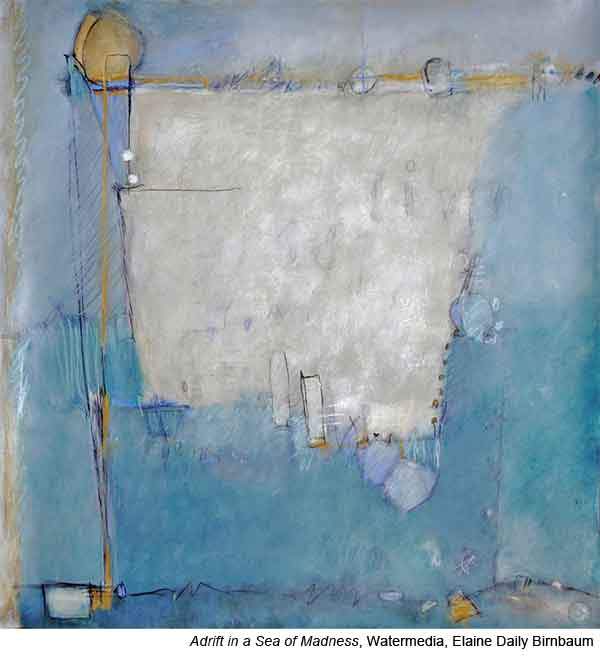
“However, I am not driven to paint for anyone but myself. The painting has to speak to me and stopping short of that is impossible.
“It’s interesting that, as artists, we know how to utilize composition principles and design elements to purposefully direct the visual experience of the viewer. We know the neuroscience of vision and can manipulate that. However, what is more important, in my opinion, is the emotional response to a painting. I can only address my personal response. I can only paint to satisfy me. That anyone else reacts positively to my paintings is a bonus but not a goal.”

CREATING A FRAMEWORK
“It’s true that there are unlimited paths to be taken in any painting. But, in the end, we, as people and as artists, are defined by the decisions we make. And the reasons for any particular decision are unique and depend on our particular wiring as well as our experiences.
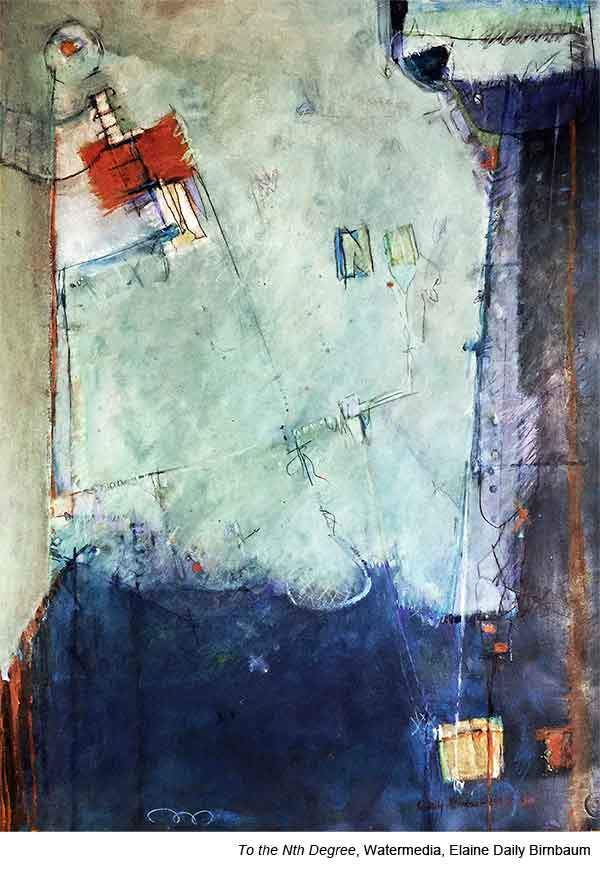
“During the initial part of the painting process, I allow myself to wander and experiment, letting my intuition guide me. Only after I have fairly firmly established the direction I want, do I stand back and begin assessing the piece in terms of composition and design.
“However, to initially paint freely and intuitively, I find I have to quiet that ever-present critic in my mind. I do this by listening to audiobooks or Ted talks while painting. When I am ready to critically evaluate the piece, I stop listening and go through a mental checklist of the principles and elements of composition and design.”
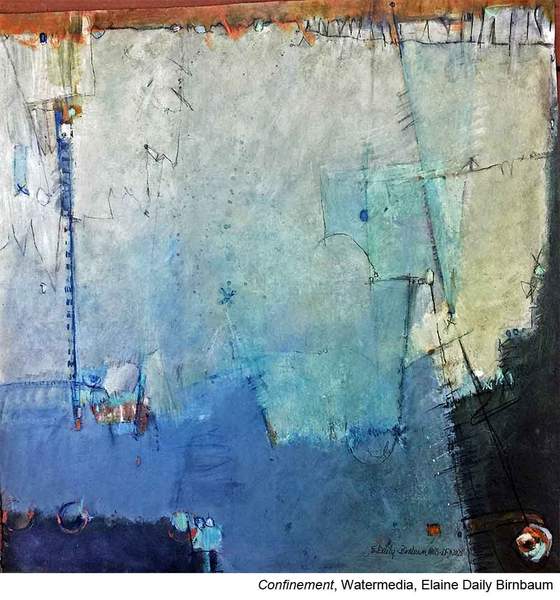
KEEPING A SKETCHBOOK
“I do have several sketchbooks, but you might be surprised to find more words or thoughts, or even potential color combinations than actual sketches. I have made some sketches, but I have never realized them in a completed painting. I may start out to do just that, but somewhere along the way, I am taken another more interesting direction.
“I do a lot of art viewing, both in the printed format and in galleries and museums. I study works of art that I like and try to determine what it is that makes them special, why I am responding favorably, and what is the quality of the piece.”

PLANNING COLOR
“I may or may not make a color decision prior to starting a painting. For the most part, though, I am not a colorist, often preferring a more neutral palette. However, I may start out with a warm (red or orange) undercoating before applying more neutral colors.
For some time I have been trying, with limited success, to create an all-white painting. I am also not very comfortable working with reds….. it kind of scares me. However, every now and then I set up a color challenge for me, such as creating an all-white or primarily red painting…. just to push my creativity process in a less comfortable way. It definitely keeps me humble!”
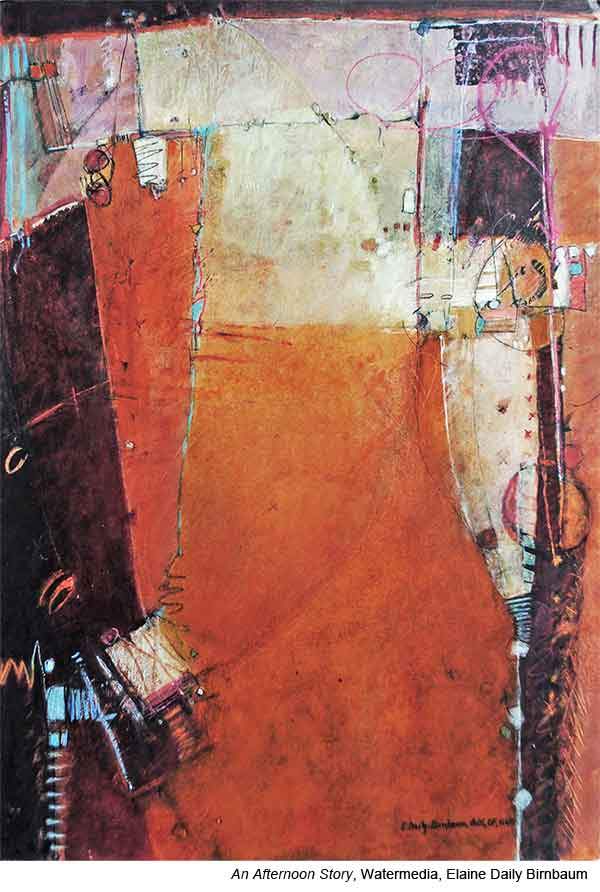
CREATING A MOOD
“Viewers often comment on the feelings of mystery, depth, and serenity in my paintings. I’m comfortable with that. This is most likely a response to the neutral palette I use, the many layers of paint I apply, and my use of large negative space that includes elements of interest such as texture and linework. I share Francis Bacon’s opinion that ‘The job of an artist is always to deepen the mystery.’ ”
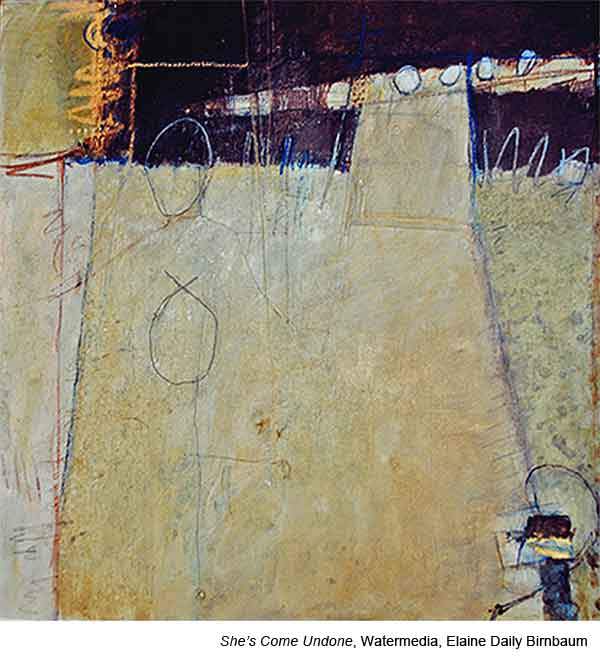
THE ELEMENTS OF DESIGN
“I am, basically, a shape- and mark-maker. These are the primary design tools I use in my creative process and the ones that contribute much to my emotional response to a painting. Most of my paintings do contain a large negative spacE. a component I have long been drawn to since my early days of studying the art of Nathan Oliveira and Richard Diebenkorn. That space is almost sacred to me, seemingly providing a place of rest, yet containing subtle elements of contrast, value, line, and texture when viewed more closely. In other words, a bit of a dichotomy.”
WHERE TO START WITH ABSTRACT PAINTING
“One typically doesn’t start out to an abstract painter; it is an evolution. Nor is abstract art, like any other visual art, part of a hierarchy. However, for those interested in abstract painting, possessing a firm grasp of compositional elements and design principles is absolutely essential. That becomes the roadmap to a successful outcome.
“Equally important, in my opinion, is understanding why one wants to paint abstractly. What about that creative process is compelling? What story or idea do you want to express?
“In addition, I would like to emphasize the mental and emotional demands of reaching deep within one’s consciousness to create a compelling image or depiction relying on shapes and color. All this, WHILE giving up some element of control and allowing the painting process to evolve. This freedom is something I struggle with, at least to some degree, in almost every one of my paintings. It is a little bit scary. But it is also the part that is the most exciting and rewarding. And did I mention CHALLENGING?”
Elaine Daily-Birnbaum is a mixed media painter. Her abstract work is deeply personal and very much process centered. She is a member of the National Watercolor Society and the American Watercolor Society.
For more inspiring stories like this one, sign up for our free weekly e-newsletter.



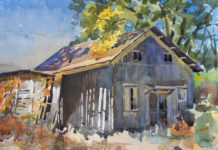




what a fabulous article on design and painting abstractly. thank you Elaine
This is the best explanation of abstraction I have ever read. Thank you.
I appreciate the hint of mystery in all art. Your process is enlightening. Thank you for sharing.
Wonderful conversion re abstract art thank you
Elaine:
This is a magnificent article that I shall keep and refer back to often. You validate my thoughts about abstract art and the process in which it is made perfectly. Thank you so much for taking the time and making the effort to share so much! Color me grateful!
Excellent article and examples, too. FYI, and I’m sure that Ms. Birnbaum has already viewed it, but John Salminen has a DVD out on abstract art in watercolor that is truly excellent, one of the best I’ve watched.
Such marvelous work, Elaine! I truly admire the complexity of your pieces and your masterful placement of color and shapes. A very enlightening article!
Elaine
This was wonderful and so revealing.
I love that you You decide when it is finished…, it must speak to you first .
Very interesting about your sketch book of words and colors and also the beginning process.
Having only stepped out onto the road to abstraction in the past year or so this article had me jumping out of my skin with delight. After twenty plus years as a representational artist and teacher i was finding the joy had evaporated and worse, boredom had set in. Moving to abstract art has re-ignited my passion for painting and this erudite article and stunning work articulates why. Thank you so much Elaine!
This article speaks to so many of us, in words I wish I’d written. Wow and Wow!!